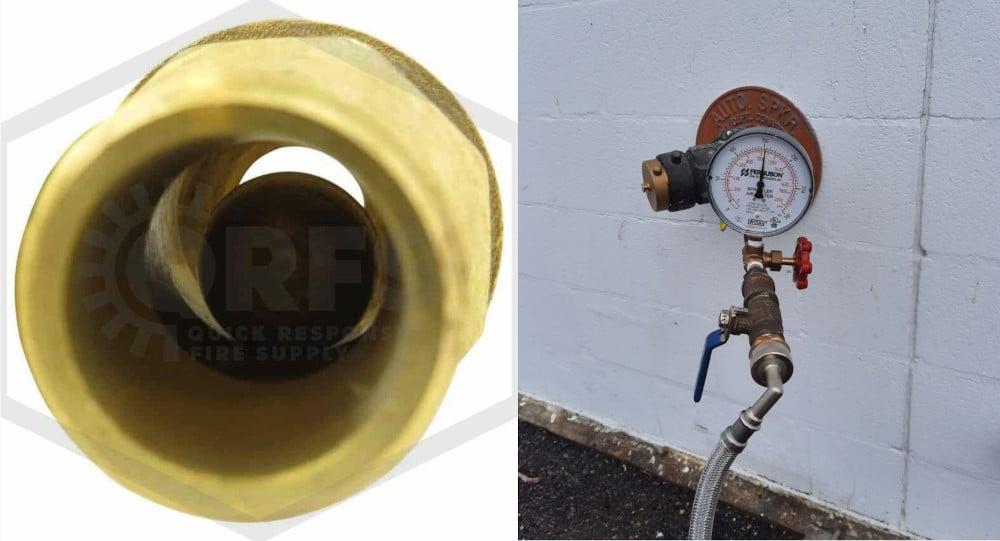… and how to address leakage from the ball drip valve below the FDC during these fire protection tests
Any system with a fire department connection (FDC) needs regular hydrostatic testing that adds pressure to verify the integrity of pipes and fittings. A ball drip valve serves as a self-closing drain at a low point near the FDC. But while they’re designed to slam shut under pressure, some water often still gets out during a hydrostatic test.
What gives? And how can fire protection pros complete a test while accounting for this leakage?
Learn the answers below. Feel free to skip down to a section of the blog that has the info you need or read our complete review:
- Why and when systems need hydrostatic tests that affect ball drip valves
- What’s a passing or failing grade?
- Why ball drip valves “leak”
- How to stop ball drip valve leakage during a hydrostatic test
- An alternative that deals with head pressure: automatic ball drip valves
If you need equipment, check out our 3/4″ ball drip valves and 1/2″ ball drip valves, plus our full selection of other fire protection valves. We also carry quality, portable hydrostatic test pumps with various GPM, PSI, weight, and electrical connection specs.
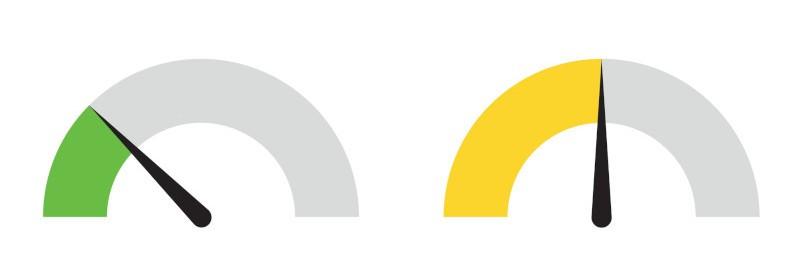
Why and when systems need regular hydrostatic tests that affect ball drip valves
Again, standpipes and fire sprinkler systems need hydrostatic tests to ensure the integrity of the pipes and fittings in the system.
There are acceptance tests for the underground and above-ground pipe in all brand-new water-based systems and significantly modified ones. You can learn about all these scenarios in our previous blog.
However, the main hydrostatic tests on existing systems that involve pumping water through the FDC and could cause ball drip valve leakage are:
- Manual standpipes and semiautomatic dry standpipes require tests of 200 PSI (or +50 PSI over working pressure for systems with working pressures above 150) every five years. (NFPA 25, 2023: 6.3.2.1*)
- Any system with an FDC needs a test of the limited section of “piping from the fire department connection to the fire department check valve” at 150 PSI every five years. (NFPA 25: 13.8.5*)
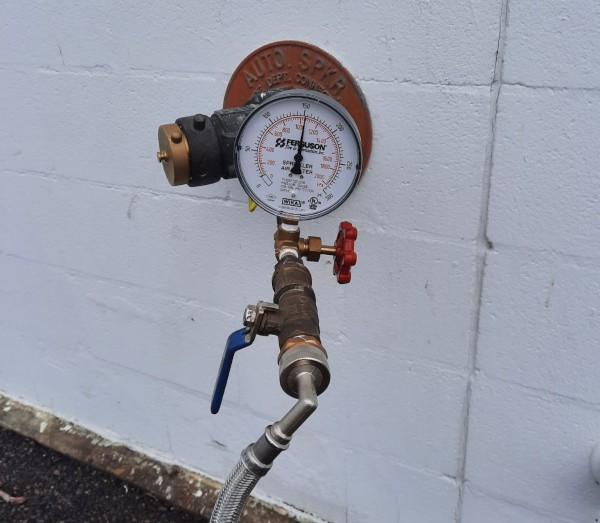
What’s a passing or failing grade?
The tests call for applying the appropriate pressure for two hours and looking for any pressure loss or leaks.
How much pressure loss? NFPA 25 used to be vague about this rule but finally clarified the number in its 2023 edition (emphasis added):
6.3.2.2.1* The standpipe piping shall show no visible signs of leakage.
6.3.2.2.2 A drop in gauge pressure of 5 psi (0.3 bar) or less shall not be considered a failure.
The same threshold applies for the five-year test of the pipe section between an FDC and the check valve (emphasis added):
13.8.5.1 An acceptable test result shall be indicated by a pressure loss less than 5 psi (0.3 bar) and no visual signs of leakage.
So, no leaks and no pressure loss hitting 5 PSI. Got it!
But what if someone sees water coming out of a ball drip valve while conducting the test? Does that count as “visible signs of leakage” and failure?
Why ball drip valves “leak”
Ball drip valves serve as automatic drains at a low point in the pipe section between the FDC and the check valve leading to the rest of the system:

Ball drip valves have a little (you guessed it) ball in the middle that allows excess water to pass by and drain out, preventing leftover fluid from getting trapped and freezing in the pipe:
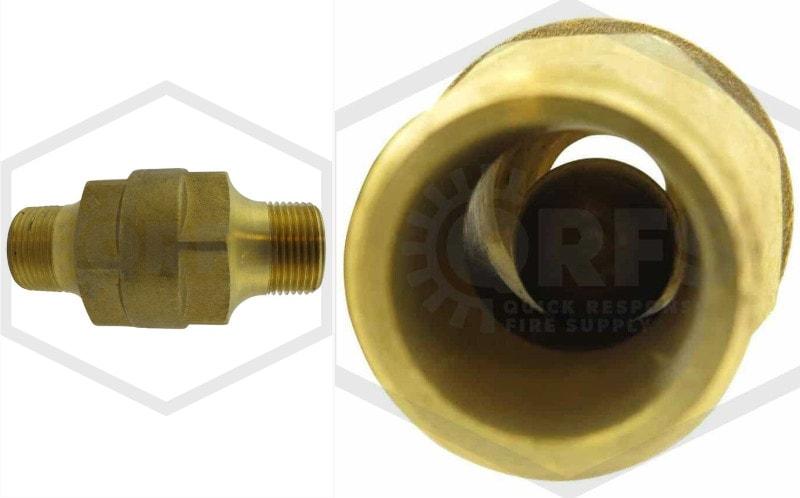
However, when firefighters or hydrostatic testers charge the fire department connection, the pressurized water slaps that little ball into place at one end of the valve. So, water can flow out when it’s not under pressure but won’t shoot out when it is and might be needed to fight a fire.
So, when is leakage a bad thing?
First, since ball drip valves are designed to drain excess water, it’s normal for one to leak after a system was charged and the pressure has been removed. It’s doing its job. However, if a ball drip valve constantly leaks with no hydrostatic test pumps or firetrucks in the picture, that indicates a leak in the check valve leading into the system. It’s a problem, but it’s not a ball-drip-valve problem.
Otherwise, it’s not uncommon for some fluid to leak out of the ball drip valve when someone pumps pressurized water into the FDC. Does this violate the no “visible signs of leakage” pass-fail criteria during a hydrostatic test?
Not necessarily—and usually, the answer is “no.”
These ball drip valves have a metal-on-metal seat for the ball; unlike some other valves, there is no nylon or PTFE.
“Nobody should expect it to be perfectly watertight,” the technical team at Lansdale, a valve manufacturer, commented. Ball drip valves may drip or even mildly spray at certain pressures, though applying even more pressure might be enough to cut this limited flow off.
We also consulted a fire marshal and an ITM pro who indicated that some leakage is common during firefighting efforts or hydrostatic tests. This minor discharge when firefighters need to supply or supplement a system during an emergency isn’t considered significant enough to impact operations.
However, normal leakage might slightly influence the PSI readings of a test and, depending on where the ball drip valve drains, cause a minor wet mess.
So, here’s what fire protection pros often do:
How to stop ball drip valve leakage during a hydrostatic test
The simple answer is to block the valve or the pipe leading to it. However, here are some additional considerations and more detailed steps to do it:
Again, it’s not unusual for some pressurized water to leak. The question is how much. For example, a very strong spray of pressurized water may indicate the valve has failed or the ball is blocked from seating, and the valve should be fixed or replaced. The primary case where a ball valve could be fixed is if an object becomes trapped in it and blocks the ball from seating properly.
An issue like this should be spotted during NFPA 25’s mandated quarterly visual inspection of FDCs; it’s number seven of the 10 items:
13.8.1 Fire department connections shall be inspected quarterly to verify the following:
(7) Automatic drain valve is in place and operating properly.
The fire official we talked to suggested that testers could run pressurized water before blocking the valve to assess whether the valve has issues. Further, a PE suggested that any leakage that would cause the hydrostatic test to fail (-5 PSI) clearly points to a problem with the valve—if the test is otherwise normal once the valve is plugged.
However, a visual inspection verifying that the ball is in place and nothing is blocking it from seating correctly indicates the ball drip valve should work fine!
Again, a little water escaping from a ball drip valve under hydrostatic test pressure is normal. To avoid a wet mess or any impact on pressure readings, fire protection pros simply block things off. There are three main ways to do this:
- Apply a 1/2″ or 3/4″ threaded cap to the end of a ball drip valve.
- Remove the ball drip valve and insert an appropriately sized threaded plug.
- Remove the ball drip valve, install a regular ball valve, and shut it.
That’s it. Individuals can conduct the hydrostatic test without any fluid or pressure losses. If the ball drip valve was removed to apply a plug, it must be put back after the test is complete!
An alternative that deals with head pressure: spring-loaded automatic ball drip valves
Some systems have spring-loaded automatic drains/ball drip valves to account for head pressure in specific setups. For example:

These models can help deal with head-pressurized water that’s left over in the pipe after firefighters or hydrostatic testers charge the system. Here’s why and how:
Let’s say a system has a Siamese FDC with two clappers instead of a single-clapper model (where the lone clapper swings between the twin inlets). Further, the pipe between the FDC and where the ball valve drains is highly elevated.
In this situation, pressurized water can remain in the pipe section between the FDC and the check valve once firefighters or testers unhook their hoses. It’s because:
- The double-clapper FDCs have clappers that snap shut without any pressurized water coming in.
- Head pressure (aka “pressure head”) accumulates in long and tall pipes. Gravity adds 1 pound of water pressure per inch for every 2.31 feet.
In that case, a high and/or long enough run of pipe leading to a regular ball drip valve might generate enough head pressure to snap the ball shut, even though the part is supposed to serve as a drain. Some water may leak out, but not very fast.
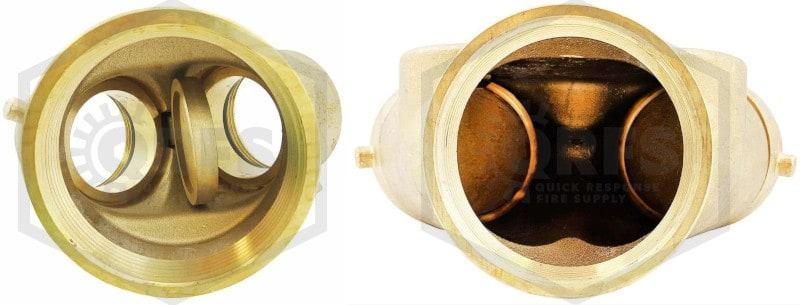
Thus, some systems employ automatic ball drip/drain valves that have a spring in them. The spring applies tension, allowing the valve to remain open at a higher pressure than a regular ball drip valve. When firefighting or hydrostatic testing hoses charge the system with even more pressure, it overcomes the tension in the spring, and the valve snaps shut.
For example, the Viking model mentioned above has a specific closing pressure of 13.5 PSI but opens at or below 12.5 PSI. This means it can account for some head pressure and stay open to drain trapped water.
Automatic ball drip valves are a good option in certain scenarios. However, they are significantly more expensive than regular ball drip valves.
A little leakage from a ball drip valve is not unusual during a hydrostatic test
Again, ball drip valves are designed to shut under pressure but aren’t entirely watertight. A little leakage is common during a fire emergency or a hydrostatic test.
It’s also normal for fire protection pros to cap a ball drip valve or remove it and plug the pipe while conducting a hydrostatic test.
Always consult with the valve manufacturer or your authority having jurisdiction if you have questions about how much leakage is too much!
If you need equipment, check out our 3/4″ ball drip valves and 1/2″ ball drip valves, plus our full selection of other fire protection valves. We also carry quality, portable hydrostatic test pumps with various GPM, PSI, weight, and connection specs.
If you’d like to purchase an automatic ball drip valve or have any questions, contact us at support@qrfs.com or 888-361-6662.
You can also check out these articles on hydrostatic testing:
- Hydrostatic Test Pump Features to Consider When Selecting a Pump
- How to Use and Troubleshoot a Hydrostatic Test Pump
This blog was originally posted at blog.qrfs.com. If this article helped you, check us out at Facebook.com/QuickResponseFireSupply or on Twitter @QuickResponseFS.


